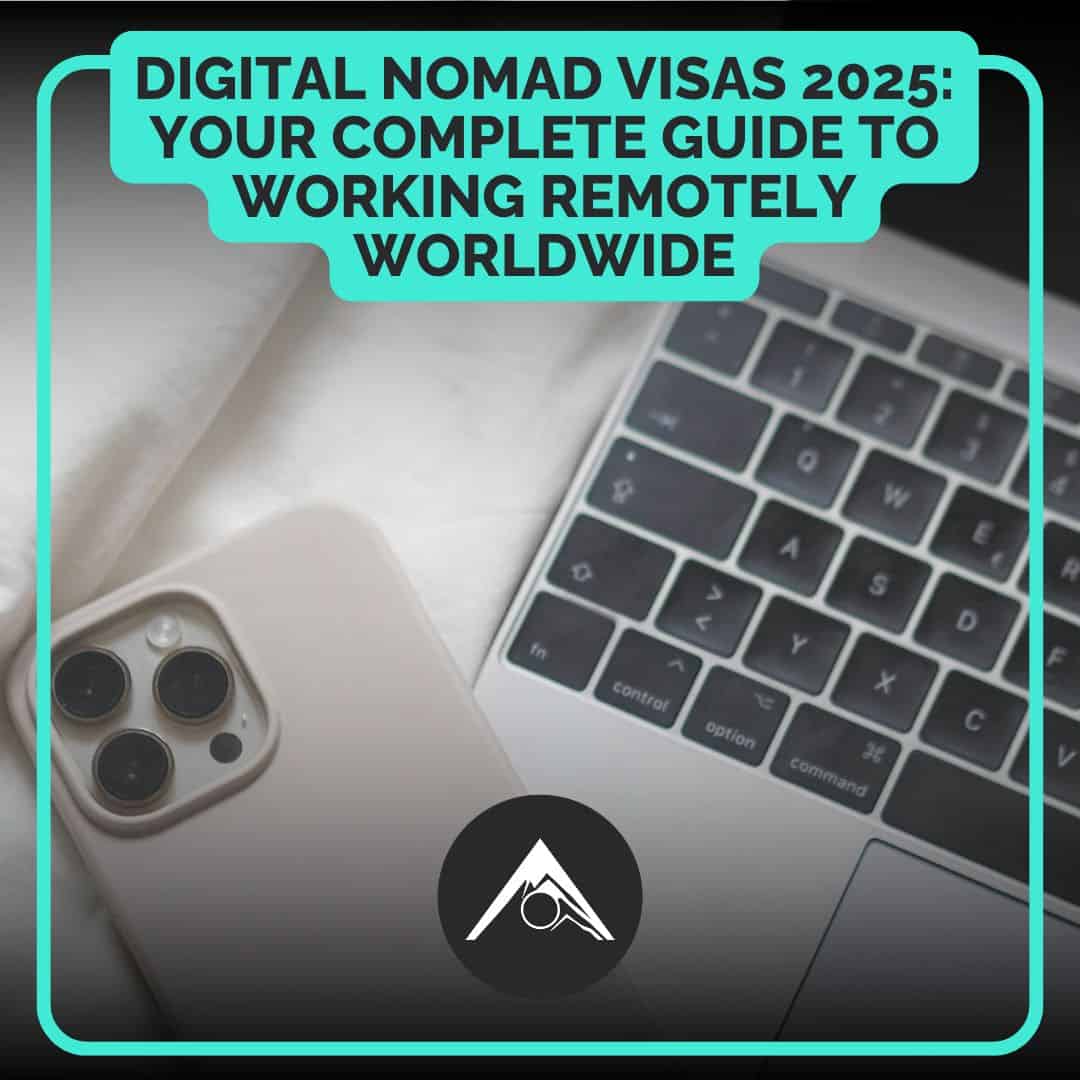Digital Nomad Visas 2025: Your Complete Guide to Working Remotely Worldwide
The world has never been more open to digital nomads than it is in 2025. With over 69 countries now offering specialized digital nomad visas, the dream of working from anywhere has become a legitimate lifestyle choice for millions of remote professionals. Whether you’re coding from a café in Lisbon, consulting from a coworking space in Medellín, or designing from a beachside office in Bali, digital nomad visas 2025 offer unprecedented opportunities for location-independent workers.
The digital nomad movement has exploded into a $787 billion global economy, with 18.1 million Americans alone now identifying as location-independent workers—a staggering 147% increase since 2019. This massive growth has prompted governments worldwide to compete for nomad talent through increasingly attractive visa programs, tax benefits, and world-class infrastructure investments.
What Are Digital Nomad Visas and Why Do You Need One?
A digital nomad visa is a specialized permit that allows remote workers to live and work legally in a foreign country while maintaining employment with companies or clients based elsewhere. Unlike tourist visas, these programs explicitly permit work activities and often provide extended stay periods ranging from six months to five years.
The key benefits include legal work authorization, extended stay periods, access to local services like banking and healthcare, potential tax advantages, and pathway opportunities to permanent residency in some countries. Most importantly, they eliminate the legal gray area that many nomads previously navigated while working on tourist visas.
Revolutionary New Digital Nomad Visas 2025
Seven major countries launched groundbreaking digital nomad visa programs in 2024-2025, fundamentally reshaping the global nomad landscape.
Thailand’s Destination Thailand Visa (DTV)
Thailand’s DTV emerged as the standout winner among new programs, offering exceptional value with a five-year validity period and 180-day stays per entry. Priced at just $280, it requires only $14,500 in bank savings and covers both remote work and “Thai soft power activities.” The unlimited entry feature during its validity period makes it potentially the most valuable nomad visa globally.
Source: Thailand’s Digital Nomad Visa Now Live – Lexology
Japan’s Digital Nomad Visa
Japan targets high-earning professionals with its new six-month program requiring ¥10 million annually (~$67,474). Available to nationals from 49 countries, it includes family members and provides access to one of the world’s most advanced economies. The program emphasizes quality over quantity, attracting skilled professionals who can contribute significantly to local innovation ecosystems.
Source: Japan Digital Nomad Visa Guide – Remofirst
South Korea’s Workation Visa (F-1-D)
Launched in January 2024, South Korea’s two-year program (extendable to three years) uniquely allows family members and taxes only income brought into Korea. This makes it particularly attractive for nomads with diverse global income sources who want to experience Asia’s tech hub while maintaining tax efficiency.
Italy’s Digital Nomad Visa
Italy’s program requires a university degree and €28,000 annually but provides renewable residence permits and potential EU citizenship pathways. The program targets skilled professionals with at least six months of experience in their field, offering one of the few nomad visas with clear permanent residency progression.
Source: Italy Digital Nomad Visa Guide – Localyze
Kenya’s Digital Nomad Work Permit
Representing Africa’s most ambitious entry into digital nomad visas 2025, Kenya’s program requires $55,000 annually and hints at potential citizenship pathways—a rare benefit in nomad visa programs. President William Ruto personally announced this initiative as part of Kenya’s broader digital transformation strategy.
Source: Kenya Digital Nomad Visa Launch – CNBC
Top Digital Nomad Visa Destinations by Region
Europe: Premium Options with EU Benefits
Portugal’s D8 Digital Nomad Visa remains a favorite despite increased requirements of €3,480 monthly income. The visa offers a pathway to permanent residency after five years and EU citizenship after six years, making it valuable for long-term planning.
Spain’s Digital Nomad Visa requires €2,762 monthly but provides the coveted “Beckham Law” tax benefit—a 24% flat rate versus Spain’s standard 45%+ progressive rates for qualifying nomads.
Croatia’s Digital Nomad Visa offers one-year stays with complete local income tax exemption for foreign-earned income, making it financially attractive for EU access.
Source: Europe Digital Nomad Visa Options 2025 – Allwork
Southeast Asia: The New Frontier
Thailand’s DTV leads the region with its five-year validity and low financial requirements.
Malaysia’s DE Rantau Nomad Pass offers 12-month stays renewable for another year, requiring only $24,000 annually—making it one of the most accessible programs globally.
Indonesia’s Second Home Visa targets high-income professionals with a $130,000 bank balance requirement but offers up to 10 years of tax-free living.
The Americas: Diverse Options
Colombia’s Digital Nomad Visa stands out with the lowest income requirement globally at just $995 monthly, offering up to two-year stays in South America’s top nomad destination.
Costa Rica’s Digital Nomad Visa provides complete local tax exemption on foreign income with equipment import benefits, requiring $3,000 monthly for individuals.
Mexico’s Temporary Resident Visa remains popular despite not being specifically designed for nomads, offering four-year renewable stays with a $2,595 monthly income requirement.
Caribbean: Tax-Free Paradises
Barbados Welcome Stamp offers 12-month stays with complete income tax exemption, requiring $50,000 annually.
Dubai’s Virtual Working Program provides one-year renewable stays with 0% income tax, requiring $3,500 monthly income.
Source: Digital Nomad Visa Countries List 2025 – Freaking Nomads
Income Requirements and Financial Planning
Digital nomad visas 2025 show significant variation in financial requirements, ranging from Colombia’s $995 monthly minimum to Japan’s $67,474 annual requirement. Most programs cluster around $2,000-$3,500 monthly income requirements.
Key financial considerations include proof of consistent income over 6-12 months, bank balance requirements separate from income proof, health insurance coverage (typically $50,000-$100,000 minimum), and application fees ranging from $50 to $3,000.
Pro tip: Aim for 125-150% of stated income requirements to account for exchange rate fluctuations and potential increases during application processing.
Tax Benefits: The Hidden Value
Only 21% of digital nomad visas offer explicit tax benefits, but these can provide substantial financial advantages. Complete tax exemption destinations include most Caribbean programs, Costa Rica, Croatia (12-month exemption), and Dubai.
Reduced tax rate destinations offer compelling benefits for longer stays. Spain’s Beckham Law provides 24% flat tax versus 45%+ standard rates, while Portugal’s NHR 2.0 offers 20% flat tax on foreign income.
The critical 183-day rule applies universally—exceeding this threshold in most countries triggers tax residency, creating liability for worldwide income taxation. Strategic nomads rotate countries every 90-180 days to avoid tax residency triggers.
Source: Digital Nomad Tax Benefits 2025 – Nomads Embassy
Application Success Strategies
Documentation Preparation: Start gathering documents 3-6 months early, including FBI background checks (which require 10-12 weeks for apostille processing), financial statements covering 6-12 months, employment contracts or client agreements, and health insurance meeting program requirements.
Processing Times: Fast-track options include UAE (14 days), Colombia (30 days), and Estonia (30 days), while traditional programs take 1-6 months. Spain typically requires 8-22 weeks from start to approval.
Success Rates: Most established programs report 85-95% approval rates for properly prepared applications. Common rejection reasons include insufficient income documentation, incomplete background checks, and inadequate health insurance coverage.
Source: Digital Nomad Visa Processing Times – Nomads Embassy
Infrastructure and Cost Considerations
The supporting infrastructure for digital nomads has reached professional standards in leading destinations. Internet speeds now meet or exceed home country standards, with South Korea leading at 121.0 Mbps and Singapore offering 264 Mbps broadband.
Monthly living costs vary dramatically by destination:
- Budget options ($800-1,500): Chiang Mai, Ho Chi Minh City, Medellín
- Mid-range ($1,500-2,500): Lisbon, Barcelona, Prague
- Premium ($2,500-4,000+): Dubai, Singapore, Zurich
The coworking space market is experiencing explosive growth, expanding from $22.01 billion in 2024 to an expected $82.12 billion by 2034. Asia-Pacific leads growth at 21% annually, providing nomads with professional work environments and networking opportunities.
Source: Best Digital Nomad Destinations 2025 – The Broke Backpacker
Emerging Challenges and Solutions
Corporate Policy Shifts: 79% of CEOs now favor in-office models, creating challenges for nomads employed by traditional companies. However, this creates opportunities for smaller companies using remote flexibility as a competitive advantage.
Program Capacity Limits: Cyprus reached its 500-permit cap and suspended applications before doubling to 1,000 permits, suggesting other popular programs may implement similar caps.
Compliance Complexity: Multiple jurisdiction tax obligations require careful planning and often professional assistance, particularly for high-earning nomads or those with complex income structures.
Source: Remote Work Trends 2025 – Pumble Learn
Your Next Steps for 2025
Choose destinations strategically based on income requirements, tax benefits, infrastructure quality, and lifestyle preferences. Costa Rica offers 0% tax with easy applications, Croatia provides one-year tax exemption with EU benefits, and Thailand’s DTV offers exceptional value with five-year validity.
Prepare documentation early, starting 6+ months before your intended departure date. Over-prepare financially by maintaining 125-150% of stated income requirements and consider professional immigration support for complex applications.
Plan for tax compliance by understanding the 183-day rule implications and structuring stays accordingly. US citizens should maximize Foreign Earned Income Exclusion benefits, while non-US citizens can leverage strategic country rotation.
Join nomad communities before relocating through platforms like Nomad List, Reddit’s r/digitalnomad, and local coworking spaces for practical insights and networking opportunities.
Digital nomad visas 2025 represent a mature, competitive market with professional infrastructure and government recognition. While corporate policy headwinds and increasing requirements create challenges, the expansion of programs and supporting infrastructure provides unprecedented opportunities for location-independent professionals.
Success depends on balancing tax efficiency, cost of living, professional infrastructure, and lifestyle preferences while maintaining compliance across multiple jurisdictions. With proper planning and strategic destination selection, nomads can achieve significant lifestyle and financial benefits while contributing to the global remote work transformation reshaping how and where we work.
The world is more open to digital nomads than ever before—the question isn’t whether you can work from anywhere, but which amazing destination you’ll choose as your next temporary home office.










